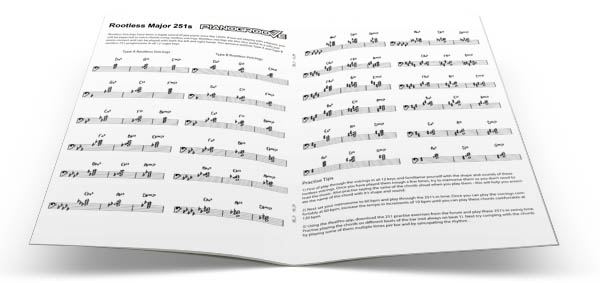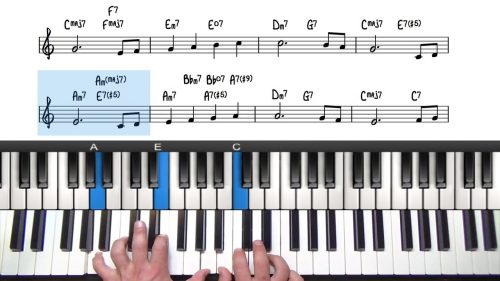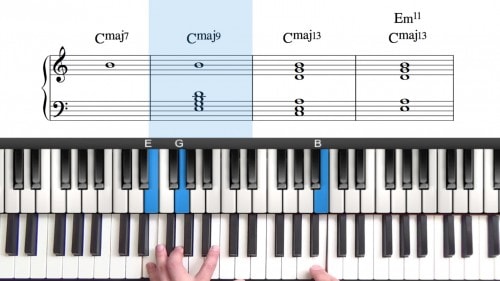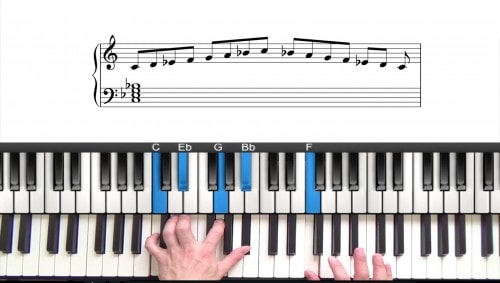The Rootless 251 Progression
Rootless voicings sound more professional then root based voicings and they voice lead much more smoothly in the context of a 251 progression. If you’ve not checked out the rootless voicings tutorial, I’d recommend you check that out before watching this lesson.
In this lesson we work through rootless 251 progressions in a number of different keys using rootless voicings.
Free Downloadable Lesson Supplement
Download this free PDF containing rootless 251 progressions in all 12 keys:

Rootless 251 progressions are also extremely useful in a solo piano context and are a great voicing choice to support soloing and improvisation in your right hand.
The Basic Major 251 Progression
To build a 251 progression, we need the 2, 5 & 1 chords from the scale. In the key of C that would give us D-7, G7 and Cmaj7.
We can use these chords to play a simple root based 251 progression and whilst this might sound OK, the rootless 251 progression sounds much more sophisticated.
What Is The Rootless 251 Progression?
Starting off with the 2 chord, D-7, we add the 9 and drop the root which gives us F – A – C — E which is the 3rd, 5th, 7th & 9th . To get to the 5 chord which is G7, all we have to do is drop one note by half a step. This note is C, the 7th of D-7.
The C drops by half a step to become the 3rd of G7 and the rest of the notes stay the same. We now have the 7th, 9th, 3rd & 13th of G13.
Then to get to the 1 chord, the 7th of G7 which is F drops by half a step to become the 3rd of C major 7 and we play a Type A Rootless Voicing for Cmaj7.
You should notice that the chords lead from one to the next very smoothly and there is also very little hand movement between the chords in a rootless 251 progression.
Playing Rootless 251s in the Left Hand
You need to be able to play rootless 251s in your left hand. These voicings are extremely useful when you come to soloing in your right hand. The reason these that they are useful is because there is very little hand movement between the chords which allows you to focus your attention on creating lines in your right hand.
Type A & Type B Rootless 251 Progression
We have just looked at a Type A rootless 251 in the key of C. Now let’s look at Type B.
To play a Type B Rootless 251, we take the top two notes of the 2 chord and put them on the bottom. This gives us a D-9 chord in its 2nd inversion.
This time, to get to G13 chord, the same movement happens (7th of D drops by half a step to become the 3rd of G). However, now that the 2 chord has been inverted, the 7th is on the bottom so it is the bottom note that drops by half a step and all other notes remain the same.
Finally to resolve to the 1 chord, we play a Type B rootless voicing for Cmaj7.
Lesson Downloads
-
Rootless Major 251 Progressions – 12 Keys File Type: pdf
Practice Tips
-
First of all play the root of the chord in your left hand and the rootless voicing in your right hand and work your way around the circle of fourths.
-
Once you are comfortable with this, drop the root and play the voicings just in your left hand.
-
Remember to practise both Type A and Type B rootless voicings so that you can always play the 251 in the correct register of the piano.
-
You should practice rootless 251s every time you sit at the piano until you can play them in all 12 keys without mistakes. Even if you just do 5 or 10 minutes a day on these progressions, you will eventually master them in all 12 keys.
- The 251 progressions (both major and minor) are the DNA of jazz and so they are the essential theory for you to learn. Virtually every jazz standard will contain a 251 in some form and so memorising these important progression will help you immensely when playing jazz standards.
Rootless 251 Formulas
For rootless major 251s, all you really need to know is these formulas:
Type A:
II Chord: b3-5-b7-9 V Chord: b7-9-3-13 (all that changes is 1 note, the b7 fell by half a step - that’s all!) I Chord: 3-5-7-9
Type B:
II Chord: b7-9-b3-5 V Chord: 3-13-b7-9 (all that changes is 1 note, the b7 fell by half a step to become the 3rd of F7 - that’s all!) I Chord: 7-9-3-5
If you’re looking for a shortcut that is all you need. That’s the blueprint. It works in all 12 major keys. Every time. ;)








I’m wondering what modes/scales to play over the 2, 5, and I. Someone told me that I can play dorian, phyrigian, and aeolion over minor 2nd chords, mixolydian over 5 chords, and lydian over 1 chords. Do you agree with that and recommend it?
Hey Josh 👋
Good question!
In modal theory, we are taught that each chord type has a corresponding scale or multiple scales.
For example a 251 in C Major, the most ‘basic’ chord scales would be:
D-7 = D Dorian Mode
G7 = G Mixolydian Mode
Cmaj7 = C Ionian Mode
If you try to improvise exclusively from the tones of these modes, you will likely find that something is missing and it doesn’t quite sound like the jazz you hear on the records.
One of the missing ingredients is chromatic passing tones and non diatonic tones.
Each mode of the major scale contains 7 notes. This leaves 5 additional tones which can be used as chromatic passing tones and intertwined within your lines. These tones add tension, dissonance and interest to your lines.
The important thing is that your lines are based on the modes of the mode and in particular the chord tones. The primary chord tones and root, 3, 5 & 7. When you do add in non diatonic tones, aim to come back to one of those tones to bring your improvised ideas back in line with the harmony.
It’s all about building tension and releasing the tension. Try play the chromatic scale over any 5 chord and then resolve into the 3rd of the 1 chord. It sounds great.
There are other nice patterns, such as the 6th falling the the #5 to the 5 over a dominant chord. Or over minor chords, the melodic minor mode which contains the major 7th is a beautiful sound.
In jazz there are no “set in stone rules”, just guidelines. If you follow the rules chances are you playing will sound still and boring
Modal theory is the foundation, it gives you the “what” but not the “how”. If you are not listening to jazz regularly and attempting to transcribe your own lines, then you are depriving yourself of the essence of the art. Jazz is not a science, there is no magic bullet to learn to improvise. The more you listen, the richer your jazz music and improvisations will become. This is a very gradual process, that you will be taking for the rest of your life. Embrace it and enjoy it!
Above anything else, I’d recommend that you listen and emulate your favourite players. Listening and transcribing is key. I wish I had figured that out sooner. You need to completely immerse yourself in the music or you will never be able to play it with conviction and sincerity.
Check out the course on improvisation, it will give you a broad overview of general concepts and techniques that you can apply to any tune: https://pianogroove.com…
Learn to transcribe as soon as possible too: https://pianogroove.com… – hands down the most effective way to learn to improvise!
Hope this helps Josh, and other questions let me know :-)
Cheers,
Hayden
Hey Josh 👋
Good question!
In modal theory, we are taught that each chord type has a corresponding scale or multiple scales.
For example a 251 in C Major, the most ‘basic’ chord scales would be:
D-7 = D Dorian Mode
G7 = G Mixolydian Mode
Cmaj7 = C Ionian Mode
If you try to improvise exclusively from the tones of these modes, you will likely find that something is missing and it doesn’t quite sound like the jazz you hear on the records.
One of the missing ingredients is chromatic passing tones and non diatonic tones.
Each mode of the major scale contains 7 notes. This leaves 5 additional tones which can be used as chromatic passing tones and intertwined within your lines. These tones add tension, dissonance and interest to your lines.
The important thing is that your lines are based on the modes of the mode and in particular the chord tones. The primary chord tones and root, 3, 5 & 7. When you do add in non diatonic tones, aim to come back to one of those tones to bring your improvised ideas back in line with the harmony.
It’s all about building tension and releasing the tension. Try play the chromatic scale over any 5 chord and then resolve into the 3rd of the 1 chord. It sounds great.
There are other nice patterns, such as the 6th falling the the #5 to the 5 over a dominant chord. Or over minor chords, the melodic minor mode which contains the major 7th is a beautiful sound.
In jazz there are no “set in stone rules”, just guidelines. If you follow the rules chances are you playing will sound still and boring
Modal theory is the foundation, it gives you the “what” but not the “how”. If you are not listening to jazz regularly and attempting to transcribe your own lines, then you are depriving yourself of the essence of the art. Jazz is not a science, there is no magic bullet to learn to improvise. The more you listen, the richer your jazz music and improvisations will become. This is a very gradual process, that you will be taking for the rest of your life. Embrace it and enjoy it!
Above anything else, I’d recommend that you listen and emulate your favourite players. Listening and transcribing is key. I wish I had figured that out sooner. You need to completely immerse yourself in the music or you will never be able to play it with conviction and sincerity.
Check out the course on improvisation, it will give you a broad overview of general concepts and techniques that you can apply to any tune: pianogroove.com/jazz-piano-lessons/how-to-improvise/
Learn to transcribe as soon as possible too: pianogroove.com/jazz-piano-lessons/how-to-transcribe-lines-solos/ – hands down the most effective way to learn to improvise!
Hope this helps Josh, and other questions let me know :-)
Hayden
Why are there only two types of rootless 251‘s? As the chords do have 4 notes there should be 4 types
HI Matthias,
Yes you are correct, any four-note chord will have 4 possible inversions.
The two types that we cover – Type A & Type B – are the easiest to visualise and execute for beginners.
With those 2 sets, you will always be able to voice the chords in the ‘sweet spot’ of the piano, which is right around Middle C for rootless voicings.
I’d recommend that you learn those 2 sets for all 12 keys as a priority, and then if you desire more options, then you can always explore other starting points on the ii-7 chord.
When we introduce the minor 251 progression later in this course, you will see that you can also add alterations to the V7 chord in major 251s. This will give you more harmonic possibilities to include specific colours and tensions in your major 251 progressions, so there is plenty more to explore with regards to these sets of voicings.
I hope this helps, if I can be of further assistance just let me know.
Cheers,
Hayden
Hello Hayden..Is there a difference between practicing with the circle of 5ths vs the circle of 4ths? Thanks!
Hi Ivan,
No there is no difference, they are just different names for the same thing. Some people say circle of 5ths, others say circle of 4ths.
If you invert any 5th interval, you will see that you then have a 4th interval.
I mention both so that you are aware of both names.
Hope this helps!
Cheers,
Hayden
Hi Hayden, my first post. I also use the 6th instead of the 7th in the Imaj chord making it a C6/9 which also sounds really nice. It works great for type A but not so much for type B. Any reason for that? Does the 6th in the root change the essence of the Imaj? Thanks
HI Manuel 👋
Thanks for posting and great question!
Yes, landing on a 6/9 chord sound beautiful. One of my favourite sounds for major chords.
When in Type B, the 6th becomes the bottom note of the voicing. The 6th is not a primary chord tone (3 & 7) and so the voicing looses some of the ‘harmonic foundation’.
In Type A, the 6th is ‘rubbing up’ again the 5th right in the middle of the voicing, and we have the 3rd (primary chord tone) on the bottom, and so it has a stronger harmonic foundation.
I would recommend using the 6/9 voicing in Type A, and perhaps sticking to the regular 7-9-3-5 voicing for Type B.
I hope this helps, and if I can be of further assistance just let me know.
Enjoy the lessons :-)
Hayden
Please correct me if I have this wrong but trying to figure out the chords for the routeless 7s had me at a little bit of a loss of trying to find what notes to play. It seems like I found an easy solution. Hopefully this doesn’t come out too confusing but let me know if there needs to be clarity.
If you are playing a chord progression G flat to B to E you would need to play the route less chords. To figure out what route less chord notes you would play you would go clockwise on the circle of fourths four steps so for example G flat is really just a B-flat but it will be in minor of course for the first chord. And then moving to the B route less you will go back four and it would be the E flat which is the route list of B and then for E you will go back for steps which should be the A flat chord.
Hi Ryan,
Personally, when I was learning this stuff, I found it most useful to take the chord, D-7 for instance, and build a major 7th chord off the minor 3rd which is F, and that would be the start of the 251 progression.
However, when I looked at that F Major 7th chord, I was seeing the notes in relation to D Minor, and not viewing the chord as an F Major7. I was seeing F as the b3, A as the 5th, C as the b7, and E as the 9th.
Then when I dropped the middle note to move to G13, I would again visualise the notes in relation to the G7 chord.
If using the circle of fifths helps you to find the voicings, then by all means use it, but it’s important not to be thinking in terms of another chord. We must be analysing each scale degree in relation to the chord whether or not the root is present.
Rootless voicings are a notoriously difficult aspect of jazz to explain, particularly for students coming from classical backgrounds.
There are a series of forum threads where I explain in more detail and answer common questions, I highly recommend that you read all of them and I’m sure you will learn some new insights:
– pianogroove.com/community/t/understanding-rootless-voicings/945
– pianogroove.com/community/t/3-rootless-voicings-practice-planner/2020
– pianogroove.com/community/t/rootless-251s-practice-inspiration-guidance/1977
– pianogroove.com/community/t/practicing-minor-251s/3038
Take a read over those posts – particularly the first one – and let me know if you have further questions.
Cheers,
Hayden
Thank you so much for the very thorough and detailed response. I absolutely understand what you’re saying and I think that is ultimately the best hurdle to get over. I was trying to find a quick and easy way but with jazz piano it’s definitely going to require a good amount of effort but once it clicks I’m sure things will get a lot easier. But your comment actually gave me more than the answer to this question. Since I started playing a few years ago I have struggled to find a good instructor. Ultimately I came to your website and have found it extremely helpful. The only downside was I felt like I was in the dark since I did not have anyone to run my questions by. Of course I don’t want to overwhelm anyone but it’s great to see that when something is stuck in my head that you put forth good effort in answering my question. Seriously thank you so much.
My pleasure Ryan – here to help if you have any further questions.
Understanding rootless harmony is a hurdle for new students, so you are certainly not alone there.
As mentioned, the forum posts are a good source of information. You can ask questions either on the lesson comments or in the forum, and you will always get a reply from myself and/or our other teachers.
Cheers and enjoy the lessons!
Hayden
Hi Hayden,
I am enjoying how much these rootless voicings are helping me on my journey to improvising with my right hand and playing with a ensemble that has a bass player.
I have a question about the dominant rootless voicings in a 2-5-1 however.
I am having an issue with the 13th on the V7 rootless voicing chords. I usually always avoid playing a 13th too low in the register (below the right hand) in my solo piano transcriptions in order to avoid the minor 9th interval that arises if I play the 7th of the V7 chord in my right hand. minor 9ths (except from the root in a V7 chord) bother my ears quite a bit, and my piano’/arranging professors also mostly encourage to avoid minor 9th intervals (this is a big topic in harmony lessons in the Berklee theory of jazz book as well)
So on to my questions: Did Bill Evans play the 13th in his left hand in these voicings while improvising and it wasn’t a big deal? Perhaps because the 7th usually is on an unstressed beat at the end of the bar leading to the 3rd of the IMaj7 chord? So in other words did he use this voicing but only play the 7th in his right hand as passing tones so the minor9th wasn’t as noticeable?
Or should I be trying to play more alterations in my left hand (i.e. the b5 or #5 instead of the 13th) so this problem doesn’t arise at all? Or is the solution simply not playing the 7th unless it’s a passing tone and perhaps not at the same time as I strike my left hand voicing with the 13th. What would Bill Evans do? ;-)
And in general, after learning the dom7 voicing with the 13th in the left hand, do you encourage us to practice with more alterations such as b9 and #5 borrowed from the minor modes and use them as extensions in the left hand voicings of Major 2-5-1 progressions?
Thanks for your help and let me know if I can clarify any of my questions better. Cheers!
Hey, and a quick follow up question: If I add alterations to the LH rootless voicings, should I be changing the scale(s) that I use to improvise with my right hand? Scales that are used to derive the specific alterations/altered chords I am using? Is there a simple way to think about this?
I realize that is a whole ‘nother big question in addition to what I asked above… just trying to conceptualize it all– and after taking a Jazz theory course this semester, my brain is full of many concepts, but I am using your lessons and website to put them to practice for the first time. Making sense of it all on a practical level is a big challenge for me. Thanks again!
Yes if you played an altered left hand voicings for a dominant chord, for example C7#5#9 – that would be perfectly suited to the C altered mode.
If you played that voicing, and then just played the vanilla C mixolydian mode, there would be a clash on the natural 9 and natural 5 or 13.
This is not the biggest of issues, and sometimes this dissonance can be nice, but you will find that your right hand melodic ideas will sound more connected to the underlying harmony when you are accentuating the altered tones over the altered voicing in your left hand.
Hope that helps and have fun playing around with this stuff.
Cheers,
Hayden
Last question for now, promise!!–
I am also having issues with the minor 9th voicing in the LH rootless voicings. When I play the minor 3rd in my right hand above the LH, this also creates the minor 9th interval problem.
I am using a basic line in my right hand (from a book called Connecting Chords with Linear Harmony by Bert Ligon) and his first outline for improvising in the right hand Is simply to learn (in the case of Dm7-G7-Cmaj7) the line: F-E-D-C (chord change to G7) B-A-G-F (chord change to Cmaj7) E.
So I start my line on the minor 3rd of Dm7, and since I am playing a minor 9th voicing in my left hand, this creates a minor 9th on the downbeat of E in LH to F in RH.
Any tips on how I can fix this or what I am thinking about incorrectly?
Hi Thomas,
For improvisation, my biggest recommendation would be to listen and transcribe. It’s difficult to conceptualise the process of improvisation into a set of rules or formulas.
By listening and transcribing, you will be learning straight from the pros. Check out this video where I explain further: pianogroove.com/community/t/the-importance-of-listening-transcribing/2737
and also get stuck into the improvisation exercises in the forum: pianogroove.com/community/c/improvisation-exercises
There are ear training exercises for all levels and also full transcription studies and analysis on improvised solos. The sooner we incorporate this into our daily practice routine, the better.
Hope this helps!
Cheers,
Hayden
Hi Thomas, yes, Bill Evans used the 13 rootless voicing a lot. If you check out the practice series in this course you will see that we also introduce the alterations such as b9s, #9s, and #5/b13.
Left hand voicings with 9s and 13s add a lot more colour to the chord. We can absolutely play just 3 and 7 to get a less dense sound. Always remember that variety is the key and we have all of these sounds and colours at our disposal.
Check out those practice drills and it should make more sense.
Cheers!
Hayden